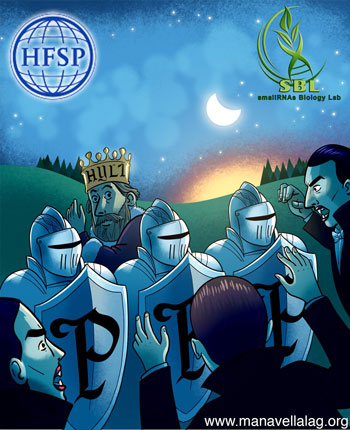As photo-autotrophic organisms, plants depend on light, a resource that may become temporarily limited. For instance, plants are inevitably exposed to darkness during the night. In addition, plants can eventually experience limited light for much longer periods (days) when seeds germinate underground, when soil disturbance causes reburial of aerial organs, and when neighbouring plants overtop their foliage. These fluctuations can challenge plant survival. Plants repress the photomorphogenic program switching to skotomorphogenesis in response to prolonged darkness. Furthermore, in response to the presence of neighbours, plants initiate shade avoidance responses. Such developmental plasticity is orchestrated at the transcriptional level by the harmonious temporal and spatial expression of specific transcription factors. Post-transcriptional gene silencing mediated by miRNAs is necessary to balance many developmental processes, including growth.

Figure: Artistic representation of the phosphor protection of the micro RNA biogenesis cofactor HYL1 that ensures a proper plant developmental response after extended periods of insufficient light. On the illustration HYL1, represented as a king, is protected from cytoplasmic proteases, represented as creatures of the night, by phosphate groups, represented as knights. A quick de-phosphorylation of HYL1 upon light restoration reactivates the protein and resumes miRNA biogenesis allowing the characteristic plant morphological changes in response to light. Artwork by Nicolas Cinquegrani (www.nicocinque.com).
In this article, we report that under prolonged periods of shade or darkness, the exclusive nuclear localization of phosphorylated HYL1 protects it from proteolytic degradation and allows the formation of an inactive protein reserve pool under periods of limited light. Upon light restoration, this inactive HYL1 reserve pool is quickly dephosphorylated to reactivate miRNA production. We found that the dynamic conversion between these HYL1 isoforms is essential to adjust plant development to the prevailing conditions. Both, the degradation of the active HYL1 formed during prolonged periods of darkness or shade as well as the presence of the phosphorylated reserve pool are necessary to support the adaptive developmental responses. This phenomenon is only triggered when the period of dark/shade extends over a normal day/night oscillation. Genome-wide, this degradation/reactivation of HYL1 produced an extensive change in the miRNA production and the regulation of specific transcription factors to control plant growth in response to darkness/shade or light. Remarkably, the quick nature of the HYL1 reactivation mechanism provides one of the few examples where post-translational regulation of a central player in miRNA biogenesis mediates a fast switch between opposite developmental responses.
Reference
A Quick HYL1-Dependent Reactivation of MicroRNA Production Is Required for a Proper Developmental Response after Extended Periods of Light Deprivation. Achkar NP, Cho SK, Poulsen C, Arce AL, Re DA, Giudicatti AJ, Karayekov E, Ryu MY, Choi SW, Harholt J, Casal JJ, Yang SW, Manavella PA. Developmental Cell. 2018 46(2):236-247. doi: 10.1016/j.devcel.2018.06.014.


































